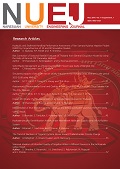Determination of fecal indicator bacteria in shallow and deep groundwater sources in the Kathmandu valley, Nepal
Main Article Content
Abstract
– Groundwater is a crucial source of water for the residents of the Kathmandu valley, with an estimated 50% of total inhabitants dependent on groundwater supply for daily use. Hence, microbial evaluation of groundwater is a paramount exigency to evaluate the impact on public health of fecal contamination of the groundwater. The purpose of this study was to compare the distribution of fecal indicator bacteria in both shallow and deep groundwater sources of the Kathmandu valley as well as to evaluate their microbial quality. A total of nine groundwater sources within the Kathmandu valley including four shallow water sources and five deep-bore wells were sampled during the study period (May-July 2015) and tested for Escherichia coli and total coliforms by the most probable number (MPN) method using Colilert reagent (Idexx Laboratories). Coliform bacteria were detected in 100% (9/9) of the groundwater samples tested and E. coli was detected in 89% (8/9) of the samples tested. The occurrence of E. coli in the shallow groundwater sources was found to be 100% (4/4) and in the deep sources was 80% (4/5), with the average value ranging from 2 to 629.4 MPN/100 ml and <1 to 3 MPN/100 ml, respectively. Similarly, the distribution of coliforms was found to be 100% in both the shallow and deep groundwater sources, with the average value ranging from 960.6 to >2419.6 MPN/100ml and 18.7 to 155.3 MPN/100ml. respectively. Deep groundwater sources were found to be comparatively less contaminated with fecal indicator bacteria compared to shallow groundwater sources. None of the groundwater samples analyzed met the drinking water quality standard recommended by World Health Organization, a finding which warrants the implementation of an effective treatment measure prior to use.


